Low velocity impact studies of E-glass/epoxy composite laminates at different thicknesses and temperatures
2020-01-07SreekanthaReddyRamaSubbaReddyVemuriMadhu
T.Sreekantha Reddy,P.Rama Subba Reddy,Vemuri Madhu
Defence Metallurgical Research Laboratory,Hyderabad,500058,India
ABSTRACT Low velocity impact experiments were carried out on E-glass/epoxy composite laminates having varying thicknesses at sub zero and elevated temperatures using hemi spherical steel impactor of 16 mm diameter with impact energies in the rage of 50-150 J.The performance of the laminates was assessed in terms of energy absorption,maximum displacement,peak force and failure behaviour.Results indicated that the effect of temperature on energy absorption of the laminate is negligible although the laminates are embrittling at sub zero temperatures.However it has influence on failure behaviour and displacement.Peak force has increased linearly with increase in laminate thickness from 5 to 10 mm.However it got reduced by 25%when temperature was increased from-20°C to 100°C.Based on experimental results,laminate perforation energies were predicted using curve fitting equations.Statistical analysis was carried out using Taguchi method to identify the global effects of various parameters on laminate performance and confirmed that the laminate thickness has significant influence as compared to temperature,for the studied range.
Keywords:Laminates Glass fibres Impact behaviour Delamination
1. Introduction
Glass fibre reinforced composite laminates have gained significant importance in aerospace and defence applications due to their high specific strength,damage tolerance and maturity in processing.They have also been recognised as an alternative energy absorbing materials for replacing steel and light alloy armour materials in impact related applications.In recent times glass fiber reinforced composites are being used as structural and applique armour in various light weight combat systems.However,composites are sensitive to out of plane impact,which can initiate damage even at very low impact energies.Hence,this area was studied extensively by many researchers [1-7]. For instance,studies on effect of temperature and impact energy on laminate performance have shown that the impact energy has minimum role to play on laminate performance whereas lowering the temperature resulted in decrease of damage area[8-12].In another study,F.J.Yang et al.[13]studied the effect of thickness(t)and temperature on critical force to initiate the damage(Pcrit)of glass/epoxy composites and reported that impact force required to initiate damage varies linearly witht3/2and influence of test temperature on damage initiation is complex.Icten et al.[14]studied the impact behaviour of GFRP laminates subjected to a low velocity impact in the temperature range of-60°C to 20°C and found that damage area decreases and threshold energy for perforation increases with decrease in temperature.Pietro Russo et al.[15]examined the lowvelocity impact behaviour of glass/polyurethane composite laminates at-50°C,-25°C&ambient temperatures and reported that lowering of temperature resulted in increase in stiffness and damage.Most of these studies were focused on thin laminates of about 3 mm thickness with impact energies upto 30 J.As the thickness of the laminate increases,the effect of temperature may vary due to increase in number of interfaces.The main objective of the present study is to evaluate the low velocity impact resistance of E-glass/epoxy composite laminate as a function of thickness,temperature and impact energy.Another objective is to predict the perforation threshold energy for different thickness laminates using curve fitting equations,and also to identify the global effects of temperature and thickness on laminate performance through Taguchi statistical analysis.
2. Experimental
2.1. Materials
Composite laminates were prepared from commercially available epoxy resin,hardener(LY556,HY5200).E-glass plain woven roving[0°/90°]having 0.25 mm thickness,360 GSM with warp and weft of 55×50 per 10 cm width was used as reinforcement.Pre-pregs were prepared by hand layup technique followed by curing under hot compression moulding.Cure temperature was maintained at 120°C for 3h followed by 160°C for 2h under 40 bar pressure.Thus laminates of 5 mm,7 mm and 10 mm thickness with an accuracy of±0.1 mm were prepared.Fibre volume fraction(Vf)of the fabricated laminates was determined as per ASTM D 3171 and found to be 0.62±0.02.Mechanical properties like tensile strength,flexural strength and interlaminar shear strength(ILSS)of the laminates were evaluated as per ASTM D 3039,D 790,D 2344, respectively and were found to be 410±10 MPa,450±20 MPa and 50±3 MPa respectively.For low velocity impact tests laminates with dimensions of 150×100 mm were cut using diamond wheel cutting machine.
2.2. Low velocity impact tests
Impact tests were performed using instrumented drop weight impact tester which is shown in Fig.1(CEAST-9350).The instrument has got climatic chamber to conduct the tests at different temperature ranges.It has got pneumatic clamping with provision of 76.2 mm diameter opening to position the test specimen.It is equipped with anti rebound mechanism to prevent the multiple hits.A steel impactor having hemi spherical tip of 16 mm diameter was attached to the striker rod.The striker was equipped with force transducer of 45 kN capacity to measure the force exerted by the test specimen on the impactor during the impact.Impactor mass was kept constant(5.277 kg)and required impact energy was achieved by dropping the impactor from a pre-calculated height.The tests were carried out at(-)20°C,(+)25°C&(+)100°C temperature.Prior to the test,the specimens were conditioned at the specified temperature for 1 h to attain the uniform temperature.The chosen impact energies were 50,100 and 150 J to cover the range of perforation and non-perforation. The corresponding impact velocities were 4.34, 6.08 and 7.51 m s-1respectively.Limited experiments were conducted at 200 J impact energy also.Complete experimental parameters are given in Table 1. Data acquisition system was used to record the force-time data at a rate of 500 kHz.Using the force-time data,impact parameters like Peak force(Fmax),absorbed energy(Ea),maximum displacement(Dmax)and impact velocity were calculated using the in-built software of the equipment[16].Minimum of three samples were tested at each energy level for each thickness and temperature.
2.3. Failure analysis
Post impacted laminates were observed visually to know the extent of damage and mode of failure[5].Areas of fibre breakage and delamination regions were measured and reported.Delamination regions were formed in distorted circle shape. Hence,perimeter of this shape was measured and area was calculated as an equivalent circle shape.Sterio microscope(Make:Leica micro systems,Model:M165C)and scanning electron microscopy(Make:FEI,Model:Quanta 400)were used to study the failure mode of laminates.

Table 1Experimental parameters.
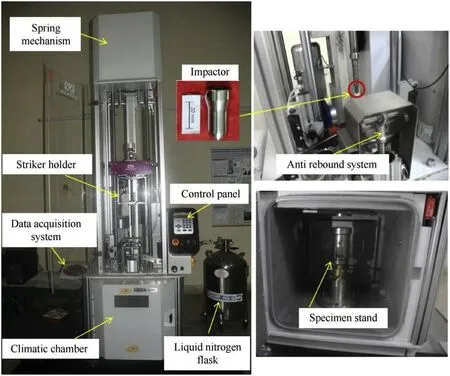
Fig.1.Instrumented drop weight impact tester(Ceast-Instron 9350 model).

Fig.2.A typical force-displacement curve depicting behaviour at different impact energies.
2.4. Statistical analysis of results
Taguchi statistical analysis was performed using Minitab®software tools in order to identify the most influential parameter among thickness,temperature and impact energy on laminate peak force and maximum displacement[17].Three variables viz.thickness,temperature and impact energy each having three levels were chosen as input factors.Peak force(Fmax)and maximum displacement(Dmax)were chosen as performance indices.Analysis trials were carried out using L27 orthogonal array with 27 combinations of process parameters that were selected to assess the influence of different factors.The results of response measures were converted into signal-to-noise(S/N)ratio by using ANOVA.Various S/N ratios exist based on the type of response.The larger the value for response likeFmax,better will be the performance,where as in case ofDmax,lower the value better will be the performance.Hence,it is represented as‘‘larger is better’’or‘‘smaller is better’’in the respective graphs[18].
3. Results&discussion
3.1. Force-displacement
Fig.2 indicates a typical force-displacement curve for rebound and complete perforation instances.Closed loop indicates partial penetration and rebound of impactor,whereas,open curve indicates the complete perforation of the specimen[14].
Fig.3(a)-(c)illustrates force-displacement curves of laminates having different thickness impacted at-20°C,25°C and 100°C respectively with 100 J impact energy.It is observed that,impactor has rebounded for all the thicknesses except for 5 mm at 150 J which is more than the laminate threshold energy.As the temperature increased number of oscillations in force-displacement curve have reduced at all thickness levels that were studied.This may be due to softening of matrix.
Table 2 gives maximum displacement values of all the laminates impacted at three incident energies and temperatures. It is observed from Table 2 that the decrease in temperature and increase in laminate thickness has resulted in reduction of displacement. This may be attributed to stiffening of matrix at low temperature and increased laminate resistance at higher thickness.For instance,maximum displacement of 5 mm thickness laminate at 100°C is 10.9 mm and it is decreased by 5.5%and 12.8%at 25°C and-20°C respectively.These observations are in line with the reported literature[11,19].
Comparison of peak force(Fmax)values of 5 mm,7 mm and 10 mm thickness laminates impacted at different temperatures and impact energies are presented in Fig.4.Peak force which indicates load bearing capacity of material has increased with increase in impact energy and laminate thickness.This may be due to increase of incident energy and laminate resistance.In the case of 5 mm laminate impacted at 50 J energy and 25°C temperature observed peak force was 13.6 kN.This has increased to 15 kN(10.2%)at 100 J and has become constant at 150 J impact energy at which the perforation of laminate was observed.From the figure it can be seen that peak force has increased by 41%and 94%for 7 mm,10 mm laminates respectively over that of 5 mm thick laminate.As far as the temperature effect is concerned,5 mm thick laminates have shown 20-25%reduction in peak force when the testing temperature was increased from-20°C to 100°C.This can be attributed to increased ductility of laminate due to softening of matrix at high temperatures.
3.2. Energy dissipation at different temperatures
Fig.5 shows energy-time curves of all the laminates impacted at 100 J energy.In a typical energy-time curve,maximum value in the curve indicates the maximum impact energy absorbed by the laminate,flat portion gives the final absorbed energy and the difference between these two gives the rebound energy or elastic energy[10].It can be seen from the figure that the absorbed energy has decreased and rebound energy has increased with increase in thickness of laminate.This may be due to increased laminate resistance and stiffness at higher thickness.On the other hand effect of temperature is found to be minimal on laminate energy absorption.For instance,5 mm thick laminate absorbed 86,89&86.5 J at-20°C,25°C&100°C respectively.

Fig.3.Force-displacement curves for 100 J impact energy at three different temperatures.
Energy profile diagrams(EPD)where absorbed energy is plotted against impact energy, indicate whether the laminates are completely perforated or not at a particular impact energy[20,21].Complete perforation of laminate occurs when the absorbed energy is equal to the impact energy i.e.when the absorbed energy falls on the equal energy line of energy profile diagram.Fig.6 shows energy profile diagrams at three different temperatures.It suggests that 5 mm thick laminates impacted at 150 J energy have completely perforated.The absorbed energies of rest of the laminates are below the equal energy line which means the perforation threshold of these laminates is higher than the studied impact energy range.These laminates were partially penetrated and the excess energy was utilized for rebound of impactor.From EPDs,it is difficult to understand the effect of temperature on laminate energy absorption as the given impact energy is below the laminate threshold energy.Hence,rebound energy(Er)against impact energy(Fig.7)was plotted to get perforation energy threshold(Ep)of each laminate for different temperatures and thickness.Experimental data was fitted in 2nd order polynomial equation.Non-zero roots of this equation give the perforation threshold energy of the laminate.The predicted threshold energy values are given in Table 3.It summarizes that the perforation threshold energy values of 5 mm laminates are similar at all the three temperatures,whereas in the case of 7 mm&10 mm laminates the threshold energies increased with decrease in temperature from 100°C to-20°C.The reason for increase in perforation threshold energies can be related to the glass transition temperature(Tg)of composites.TheTgof E-glass/epoxy composites is 133°C[22].Below theTg,polymer molecules become stiff and behave like a rigid structure due to decrease of Brownian movement and this effect seems to be more prominent at higher laminate thickness[23].The predicted perforation threshold energies were validated by measuring experimentally at 25°C and found to be matching closely.

Table 2Comparison of maximum displacement values for all the laminates at three different temperatures and impact energies.

Fig.4.Comparison of Fmax Vs laminate thickness at different temperatures.

Fig.5.Energy-time curves for 100 J impact energy at three different temperatures.
3.3. Effect of thickness and temperature on damage behaviour
Fig.8 shows impacted laminate which depicts various damage modes.Visual observation of impacted laminates revealed that surface cracking,indentation,matrix cracking,bending of laminates,delamination and fibre breakage are found to be prominent damage mechanisms.All these damage modes were confirmed by optical and scanning electron microscopic(SEM)analysis(Fig.9).
Length of impact surface cracking and diameter of indentation were found to be increased with increase in temperature as well as increase in impact energy.Delamination area is decreased with increase in temperature whereas the amount of fibre breakage at back surface is increased.When compared the effect of thickness on damage modes,it is found that delamination area is increased for 5 mm-7 mm and then decreased for 10 mm laminate,whereas,fibre breakage area is decreased with increase in laminate thickness.Images of all the thickness laminates impacted at different temperatures and impact energies are given in Fig.10 and complete quantitative damage analysis is as follows.

Fig.6.Energy profile diagrams at three different temperatures.

Fig.7.Perforation energy threshold diagrams with 2nd order polynomial fit at three different temperatures.

Table 3Perforation threshold energies(Ep)predicted from curve fitting of Fig.7 and experimentally measured values.
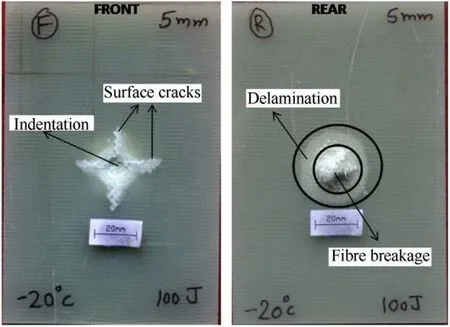
Fig.8.Photographs of impacted laminates showing various damage modes.
Fibre breakage area and delamination area of all the laminates impacted at different energies at 25°C were calculated and given in Fig.11.Fibre breakage area has come down at all the impact energies with the increase of thickness.For instance,fibre breakage area for 5 mm, 7 mm&10 mm thick laminates was found to be 5.75,2.15 & 0 cm2respectively, when impacted with 100 J energy.Delamination areas were found to be in the range of 5-45 cm2for the laminates tested in the impact energy regime as shown in Fig.11(b).Damage areas of all the laminates impacted at 3 different temperatures are presented in Table 4.From the table it is observed that the total damage area has decreased as the testing temperature was increased from-20°C to 100°C.As discussed previously this may be due to decreased brittleness of polymer matrix at higher temperature.These observations are in line with the findings of S Benli et al.[24].
3.4. Statistical analysis by Taguchi method
Fig.12 shows Taguchi statistical analysis data on effect of various parameters onFmax.It is observed that the thickness has high degree of influence onFmaxwhere as temperature and impact energy has moderate effect.SinceFmaxis‘larger is better’type characteristic,higher thickness and lower temperature will give the betterFmax.Similarly,Fig.13 describes the effect of experimental variables onDmaxand found that the thickness and impact energy have significant influence as compared to temperature.The quantitative result of ANOVA are presented in Table 5.It can be noted that the largeFvalue(statistical value which is different fromFmax)indicates larger influence of that particular parameter on performance indices(Fmax&Dmax).From the table it can be seen that the thickness has highest influence onFmax,whereas,impact energy has major effect onDmax.When we take 95%confidence level i.ep<0.05,it is deciphered thatFmaxwas influenced by all the three parameters andDmaxwas affected by only thickness&impact energy.
4. Conclusions
E-glass/epoxy composite laminates were studied under low velocity impact conditions as a function of laminate thickness and temperature(viz.-20,25 and 100°C)on impact parameters like peak force,maximum displacement,perforation threshold energy and damage area.The following conclusions were arrived from this study.
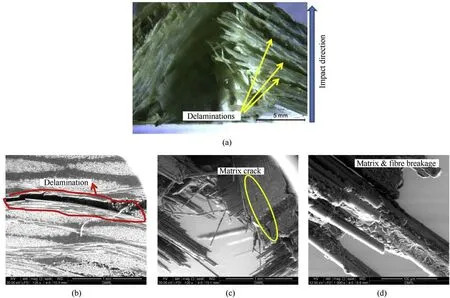
Fig.9.(a)Optical and(b)-(d)SEM images of 5 mm thick laminate impacted at 150 J

Fig.10.Images of all laminates impacted at three different temperatures&energies.
(1)Maximum displacement of laminate has decreased with increase of laminate thickness as more volume of material is engaged in dissipation of impact energy at higher thickness.Further, maximum displacement has decreased with lowering of temperature due to stiffening of matrix at low temperature.
(2)Effect of temperature on perforation threshold energy is found to be more significant at higher thickness laminates due to increase of laminate rigidity at low temperature.
(3)Perforation threshold energy has increased linearly with the increase in laminate thickness.The predicted perforation energies are closely matching with the experimentally measured values.
(4)Microscopy analysis on impacted laminates showed that matrix cracking,delamination and fibre breakage are the main energy absorption mechanisms.
(5)Statistical analysis of the results have shown that the laminate thickness has highest influence on peak force due to increase of resistance and stiffness.However,thickness and impact energy have significant effect on displacement.
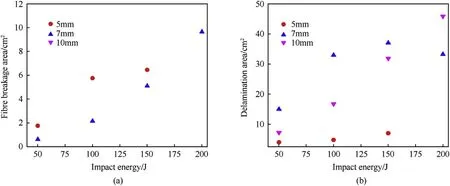
Fig.11.(a)Fibre breakage area and(b)Delamination area of all the laminates impacted at different energies at 25°C.

Table 4Damage areas of all the laminates impacted at three different temperatures.
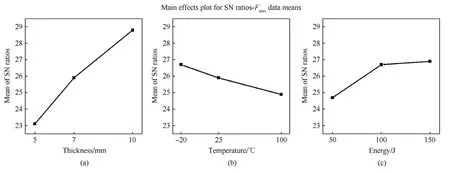
Fig.12.Effect of experimental variables on Fmax.

Fig.13.Effect of experimental variables on Dmax.

Table 5Analysis of variance for S/N ratios for Fmax and Dmax.
Acknowledgements
Authors gratefully acknowledge Dr. Vikas Kumar, Director,Defence Metallurgical Research Laboratory(DMRL),Hyderabad for his encouragement to publish this work.Authors also acknowledge the support rendered by the staff of Armour Design and Development Division(ADDD).Authors specially thank Mr.Ravindranadh Bobbili of ADDD for his help in Taguchi analysis.
杂志排行
Defence Technology的其它文章
- Round robin using the depth of penetration test method on an armour grade alumina
- Sonochemically assisted synthesis of nano HMX
- Effect of particle gradation of aluminum on the explosion field pressure and temperature of RDX-based explosives in vacuum and air atmosphere
- FEM analysis and experimental investigation of force and chip formation on hot turning of Inconel 625
- Study on liquid-filled structure target with shaped charge vertical penetration
- Thermal decomposition of ammonium perchlorate catalyzed with CuO nanoparticles
